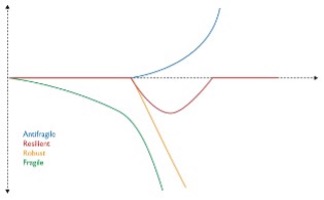Procurement trends after the pandemic
As the world begins to recover, what procurement trends are we likely to see and how will this affect bid strategy to win a contract? We have so much to reflect on about adaptation and change from the many waves of the COVID-19 pandemic, and the procurement mayhem and supply chain disruptions that occurred.
Whilst such a crisis has reminded those of us in business just how fragile the supply chain is (and that our risk management plans were focused too much on ‘known’ risks), we have also seized new opportunities to become more interconnected, and accepting of new technologies and novel ways of finding solutions.
This phenomenon is more than just being resilient and robust; it’s what is more popularly termed as being ‘anti-fragile’ – a thing or system that not only survives at stress, but flourishes and gets better. So what emerging cross industry procurement trends can bidding organisations expect to see, and what do they need to ‘bend’ in order to ultimately come back stronger?
“You never want a serious crisis to go to waste.” Rahm Emanuel
(former Chief of Staff to Barack Obama)
Introduction
In Nassim Nicholas Taleb’s book, Antifragile, he talks about Black Swans, described as “large-scale unpredictable and irregular events of massive consequences.” When we think of other Black Swan events – the world wars, the internet and global financial crisis – they all profoundly shaped our world and disrupted companies to either thrive or demise.

Above: the opposite of fragility is not robustness or resilience, but antifragility (source: Leading Edge Forum)
COVID-19’s universal threat to humankind. which spread through 114 countries within the first three months, has profoundly impacted lives and caused financial instability and job losses worldwide.
Decisive actions to mitigate and contain the virus – and its seemingly endless mutations – has placed new challenges and added obligations on businesses and households – from mass immobilization and remote working, to distance learning and contactless deliveries.
Procurement has evolved rapidly since the COVID-19 pandemic began, forcing companies to rethink how they plan, react, connect and respond with their ecosystem of suppliers, external partners and customers.
On the flipside, bidding and tender professionals have faced their own rapid adjustments. Some bid teams were stood down from cancelled or postponed tenders. Others supported their logistics departments in the response to frantic calls for essential supplies at unprecedented levels, including via unconventional channels such as Twitter (pictured below).

Above: A single Tweet from NYC in March 2020 highlighted the scale of the COVID-19
procurement problem, but also how dire system-wide inefficiency had become. Source: Twitter
So if we take a leaf from Taleb’s Antifragile book, the world is changing. So are you changing with it?
Bidding professionals have long been fast to adapt to peaks and troughs of procurement activity, and in managing everyday chaos in pressure cooker environments. Variability is a bid team’s routine.
Here we highlight 7 procurement trends to be prepared for, and how they will affect organisational bidding and technology adoption strategy.
Procurement Trend #1
Supply chain networks reimagined
As the pandemic unfolded, we saw a system evolve, where business-government cooperation and citizen involvement unveiled the potential of integrated solutions being used as a lever to build local resilience and national innovation. But without price controls or rationing, we also witnessed the downside of public-private collaborations where political interests, critical shortages and price-gouging fueled social discontent and contributed to further supply chain imbalances.
In the COVID-19 emergency context, the lack of coordination between governments, hospitals and retailers all placing orders at the same time highlighted a fragmented, broken system that needed to change. Many companies discovered that even dual sourcing didn’t cushion the blow because of multi-country supply chain failures. Lack of visibility into inventory levels – what goods were available, and where – led to panic buying and hoarding which could have been avoided had there been end-to-end visibility of stock and suppliers, and sense and respond technology across the global supply chain.
COVID-19 exposed weaknesses of single large-scale manufacturing centres, and highlighted the strength of having human assets to drive agility. As a result we’ll likely see procurement departments accelerate their research into alternative suppliers leading to:
- more flexibility and multi-level sourcing;
- a rapid shift from globalisation to regionalisation – and localisation – of logistics hubs; and
- real-time inventory views providing upstream and downstream traceability, from manufacturer to final destination.
Blockchain, which offers the building blocks to trading partners and consumers to address challenges around fragmented supply chains is claimed to provide transparency and real-time data flow from source to shelf (‘what I see is what you see’). Blockchain was developed in 2009 by Bitcoin inventor Satoshi Nakamoto. The World Economic Forum has prepared a toolkit to guide companies through the development and deployment of blockchain, although mainstream uptake is predicted to be slower than originally hyped.
Procurement Trend #2
Bid strategy will become more multidisciplinary
For companies that rely on bidding for their revenue pipeline, the inability to win or renew contracts through the regulated procurement process can irrevocably harm operations and significantly reduce or eliminate profits.
Procurement cancellations and delays, followed by the onslaught of stimulus packages has placed pressures on bid teams to either ramp up and seek reprieve through technology solutions and externally hired help; while in-house bid teams in vulnerable industries look for other ways to use their time proactively, such as reviewing bid content libraries or upskilling with online training.
Bid strategy and team-orientation will therefore move higher up the value chain with:
- opportunity identification and qualification, capture management, and proposal development being far more integrated;
- intelligence gathering, relationship management, market analysis and pipeline development being core to transforming qualified opportunities into wins;
- sales and operations teams being more involved in bid strategies; and
- greater emphasis on debriefs following each bid to discuss learning points and implementation of agreed actions.
Silos will be removed and enterprise visibility will open up. Those companies that fail to plan and invest in collaborative bid tools will otherwise lose time from the start of their bid schedules which will have a compounding, negative effect on success rates.
Procurement Trend #3
Expect more work packages over multi-year contracts
There are many twists and turns in the procurement landscape where policy is monitored and risks and uncertainties have to be managed in line with the cyclical shifts that occur between insourcing, outsourcing and co-sourcing models. Contractors should expect to have their single contracts put out to tender early or at best, re-tendered under a multi-source arrangement to spread supplier and geographic risk. Procurement is likely to:
- increase their use of ‘mega panels’ or ‘frameworks’ in which multiple contractors are qualified for a specific program or category of work;
- replace large, programmatic assignments with smaller packages of shorter duration and award task orders or projects across the qualified contractors; and
- encourage greater involvement from small businesses and minority owned companies.
Procurement Trend #4
Anticipate increased multi-partner involvement
Multi-partner collaborations don’t have to rely on existing consortia but any collaboration must demonstrate that it brings together capabilities, expertise and resources necessary to address the proposed project.
In the new bidding environment this may include clustering of partners that have the greatest potential to make an impact, and co-location of partners is now unlikely to be a deal breaker given remote is the new normal.
Inter-company initiatives will reinforce the importance of internal coordination, but with collective resources new challenges will be presented. These include:
- the need for collaboration tools that support interdisciplinary input into solutions development;
- adapting internal coordination structures and opening them up to external collaborators; and
- implementing strategies to research, anticipate and position your company as a preferred partner for future procurement opportunities.
Key watch points for companies seeking collaborations will be the need for clear contract leadership and accountability, and strategic use of the contract funds across the partnership to deliver optimum value for money outcomes. There will also need to be agreement over intellectual property ownership, and clear mechanisms for monitoring and reporting of progress across each of the partner organizations.
Procurement Trend #5
Local wisdom counts
Being qualified to deliver a contract is no longer the only criterion to win bids. As governments increasingly design policies to protect small businesses and underrepresented minority contractors, there are distinctive contributions and expertise that can be brought to the table.
A major lesson from COVID-19 is that effective collaborations are driven by the people who collaborate, not the institutions. There’s a ripple and scaling effect in local communities connecting and mobilizing to take up collection action. Local businesses with grassroots knowledge and experience in community engagement are more than ever providing leadership and strategic insight into their local market.
Procurement and industry need to support the development and extend these collaborative working opportunities at the local level. Platforms that bring together multiple stakeholders that are priced for accessibility and which lower barriers to collaboration are important enablers to this process.
Procurement Trend #6
Accelerated digitisation and remote collaboration
Grandparents having virtual calls with their grandchildren might have been an impossible idea only a couple of years ago, yet being together while apart with screen time has connected generations of families around the world.
COVID-19 has also expedited the fourth industrial revolution and digitalization of corporate and public services. We have seen the remarkable response from children using their classroom 3D printers to deliver protective equipment to hospitals, of high street fashion labels pivoting to provide hospital gowns and masks, and rapid adoption of telehealth to deliver essential health services while protecting the vulnerable and frontline workers.
Gartner estimated that $3.7 trillion would be spent on IT spending in 2020, and while some strategic transformation projects were put on hold, actual Cloud use grew by 19% in 2020, reaching $3.4 trillion. That figure is now predicted to reach $4.5 trillion in 2022. Enterprises and small to medium businesses that had not yet migrated to the Cloud with browser-based Software as a Service (SaaS) tools accelerated their plans and, while a seemingly incremental change, the shift has provided a radical breakthrough in enabling workforces to remain productive, more agile and connected. Over 89 percent of companies now use SaaS products, according to IDG.
Previously, high expectations of interoperability between collaboration tools often led to false assumptions and over-engineered solutions which blocked agility and caused ‘change fatigue’ in some business situations. The COVID-19 situation, however, has unlocked entrenched IT restrictions and unnecessarily expensive IT system deployments. This has opened up enterprises to more agile tools and creative and collaborative partnerships. It has also enabled teams to identify new ways of working.
Procurement Trend #7
Knowledge management as a competitive differentiator
As people transitioned to full remote work, companies that weren’t prepared realized the importance of project management and remote communication tools for their business, with bid teams being no exception. Knowledge hoarding is one the most important collaboration barriers, creating inefficiencies and financial costs to companies. Research published in the Journal of Organizational Behavior found that the way jobs are designed can affect whether employees share or hide knowledge from their colleagues.
Cognitively complex jobs such as bid management rely on people to process large amounts of information and solve complex problems so it is little wonder that investment in collaboration and productivity software has increased for tools that:
- provide a central hub for team members to learn and share information across disciplinary and organisational boundaries;
- support task identification, problem solving and quality decision making;
- host high performance project spaces where knowledge can be put into action before it is outdated; and
- deliver data sharing and analytics to drive value.
The importance of human-centred collaboration – internally and externally – has certainly been exposed by COVID-19. We’ve learned that there is a very real need to reduce dependency on physical offices, but like all human endeavours we need to check in regularly on the physical, mental and emotional health of core and extended workforces, especially given the rise of the remote ‘gig working’ model. We must reshape ways of working to maximize investments in digital technologies that support smarter ways of working.
Lessons learned to having an antifragile mindsest
The aftermath of this pandemic will force bid teams to build strength and accept that there will be new procurement models that consider:
- the creation of a portfolio of suppliers who can be called on in an emergency;
- the awarding of contracts to capable but reliable suppliers; and
- the development of contracts that are outcomes-driven and flexible to changing macro forces.
Innovation is iterative, not an all-out solution. The technology sector will continue to play a significant role in supporting and accelerating governments, citizens and businesses’ ability to adapt and innovate through trial and error to become learning machines so that they come back stronger and ultimately, become ‘antifragile’. Co-design with citizens and stakeholders for policy and service design has often been attempted but frequently not realized as the structure and culture of government is not suited to this approach. Policy officials have traditionally not responded well to the risks of diminished control. Yet the response to COVID-19 has highlighted the benefit of the triple helix model, where university /industry (startup)/ government relations can create real change with experimental, market-oriented and responsive solutions
Independent but interconnected networks lead to new learnings. Historically, In the context of the perceived risk of fraud and corruption in procurement and the mandate for transparency and bureaucratic conformity, governments around the world often miss out on fostering true collaboration to facilitate strategic public procurement. But the interactions between citizens and government, and the Herculean effort that agencies are undertaking to partner with the private sector to deliver critical services and support economic recovery show that there are many positives that will come from this historic time. One such positive in using procurement to achieve policy goals includes building business resilience, embracing innovation, supporting national production and celebrating diversity in suppliers.
If there was any time in history that procurement and contract bidding has been showcased as being a true engine of an economy, it is now.

Enter your email to unlock this content
If you'd like to read this locked content in full just enter your email and click unlock.
It's as simple as that.
And we promise we won't bombard you with emails and newsletters.
Sure we might send you one every now and then.
But it's ok... you can opt out at any time.
Unlocked!







